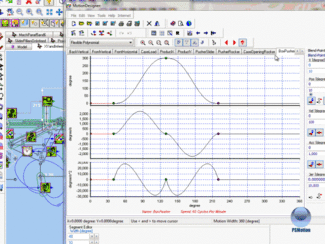
Motion Design for packaging machines has been around for as long as...well...packaging machines. There has always been a need to mechanically move, fold, tuck, lift, twist, transfer … or in some way manipulate packaging and the product to give a package. As soon as something moves in a machine, then a motion needs to be designed for it. More typically, a number of motions need to be weaved together.
Unfortunately, motion is completely abstract. You cannot 'see' it. Only the results of it can be seen. A motion cannot be bought on eBay - so don't start bidding on one. Fortunately, the great thing about 'motion', and motion-design, is it is completely free!
Good motion-design is free.
However, bad motion is also free! If bad motion design is incorporated into packaging machine mechanisms, servos or cams, the machine will jam more often, need maintaining more often, not run as fast, be noisier and not last as long. It will look like your dad trying to dance at your wedding. You just know something, his 'motion-design', is all wrong. His arms and legs are not coordinated, to put it kindly.
However, if good motion design is used on the SAME machine, then the machine can be completely transformed in to a highly efficient, reliable, fast, quiet, and long-lasting machine. The SAME machine with DIFFERENT motion design - to labor the point.
The machine is transformed from your dad dancing, embarrassingly, at your wedding, to Rudolf Nureyev performing in The Swan Lake. He seems to perform greater things, with less effort; he lasts longer and has more beauty.
But Nureyev is merely one performer. Of course, in a ballet, there are many performers, each highly skilled, each with years of training. The skilled performers still need careful and thoughtful choreography from an artistic director, with many dress rehearsals, before they can put on an opening performance.
Similarly, there is not just one skilled performer on a modern packaging machine, there are many. To collectively produce a great machine performance, each motion needs to be a 'skilled performer' in its own right, and there needs to be an artistic director that can successfully craft and choreograph them together.
Like great dancing, great motion design for packaging machinery is a skill that needs to be carefully developed. First, you need the knowledge of what constitutes good motion design and bad motion design for an individual axis. You then need to develop your skills, as artistic director, to bring all the individual motion performers together. You are looking for the overall best result and machine performance.
At PSMotion, we have software to develop the skills you need. Software that allow you to easily design all the motions needed for your machine in one application and one setting; software that also lets you easily associate each motion design with a mechanism; each mechanism performing one function in a complete machine model. And finally, software that lets you see your machine dancing like it is meant to - instantly, tirelessly, and easily corrected to get the polished performance you want. Once you cut metal, you know your opening performance will have no surprises.
Our aim at PSMotion is simple. To give you the best software and the best training for developing the knowledge and skills needed to get the best performance out of your packaging machine.
Software now available, that is easy to use yet sophisticated in design and comprehensive in its reach.
MechDesigner - A force to be reckoned with.
In the coming weeks and months I will be discussing and developing motion, mechanism, machine design and modeling. So please come back and look for updates.

